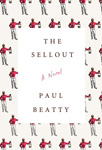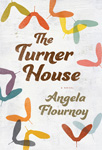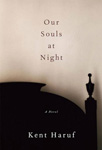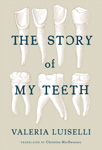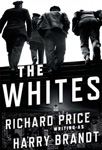by Chris Adrian and Eli Horowitz
Buy it at Powell’s »Jess Zimmerman: I live in a few hundred square feet in Brooklyn, which means I rarely buy actual books. Most of my library lives in my Kindle, taking up space in a purely digital way. So when I do get books, I’m distinctly aware of their physicality: the heft of them, the bodily engagement. To be handed two hardcover books and asked to read them both in a short period of time is, for me, a mandate to consider the book not only as a story, isolated from the reading and the thing read, but as something substantial and procedural. To sit with the book, yes, but also in a way to sit in the book, to engage it as a physical object and experience the story as though it’s a physical space.
I guess this is why I couldn’t stop thinking about these books in terms of chairs.
As a chair, Our Souls at Night is a designer stool made out of a single block of bleached wood, with maybe a bit of a depression where you sit. Maybe even one depression for each buttock. It’s attractive, in a clean way, and you can easily imagine it adding austere grace to a Better Homes and Gardens spread that also features a pure white, mid-century modern sofa with a solid-color cashmere throw. But it’s missing some essential elements of usability and comfort. In the case of the chair that would be the back and arms; for the book it’s quotation marks and solid characterization, both jarring omissions in a work that’s mainly dialogue.
The book concerns the late-life romance of Addie Moore and Louis Waters, both widowed and both around 70 years old. In the opening pages Addie approaches Louis, a neighbor, to ask whether he would like to start keeping her company at night—not, she’s quick to add, in a sexual way, though this doesn’t keep the neighbors from talking. Louis says “I don’t know” and then “what if I snore?” and then to himself he says “what in the hell” and “now don’t get ahead of yourself,” although he says all of these things without quotation marks, and then the next day he goes to the barber and has a shave and goes to Addie’s house and says “I’d like to come over tonight if that’s still all right.” The book goes on to describe the growing closeness between Addie and Louis, their histories, the difficult-to-fathom disapproval of their neighbors and families, but the reader’s window into their minds never opens further than it does in this first exchange. We are told what they do and say, but shown nothing of the why.
Again, I can see how this would have a spartan appeal as a love story with no messy mucking around in the characters’ heads. But for me, it’s conspicuously lacking in warmth—a chair with no cushions, no upholstery, nothing to lean on. I found most people’s motivations either opaque, senseless, or both, and the lack of quote marks so needlessly obfuscatory and disruptive that I probably couldn’t have gotten into it anyway. In the end, the story didn’t satisfy me, and the process of finding that out was simply uncomfortable.
The Turner House, by contrast, is an armchair, an enormous, expansive, lived-in armchair, beautifully weathered, built to last. It’s not precisely a “they don’t build them this way anymore” kind of heirloom piece—it’s built the way they build them now, with a few rough edges, some spots where the joins are a little askew. (My main complaint about the book was a light but glaring smattering of careless errors, things the copy editor should have easily caught if copy editing is still a thing.) But it’s comfortable, functional, beautiful, and inviting. You’re happy to stay there. You don’t really want to get up.
It is also, rather subtly and quietly, significant. (The chair metaphor breaks down here; chairs are rarely significant. I mean, there are exceptions—various thrones, the Siege Perilous, that chair Clint Eastwood talked to—but I’ll just say that my metaphor is imperfect and leave it there.) Though The Turner House tells many stories, it is primarily about adult siblings trying to decide what to do about their family home on Detroit’s crumbling East Side. It’s a house they grew up in and loved, but it’s also a house that’s worth a fraction of what their mother owes. In exploring the fate of the house, which may or may not be haunted, Flournoy takes on questions of fidelity, loyalty, trauma, addiction, race, poverty, generation gaps, responsibility, belief, and economic collapse. But these themes appear in much the same way they would appear in life: not overtly or self-consciously, but in the normal course of things, as part of the challenge of existing as a human in the world.
The scope of The Turner House dwarfs the two-person idyll of Our Souls at Night: There are 13 Turner siblings, plus their parents and some of their children, and the action shuttles back and forth from 2008 to 1944. But it never feels sprawling, not even in the lush The House of the Spirits way that a good multigenerational epic can sometimes sprawl. Flournoy’s writing style is unobtrusive and straightforward, evocative but not showy; it shows confidence in its solid craftsmanship, without resorting to writerly furbelows. She keeps the focus tight by deputizing three of the Turner children (in 2008) and their parents (in 1944) as viewpoint characters. They become the focal points through which we see the rest of the family, and through the family, Detroit, and through Detroit, America. Though the family tree on the flyleaf might make some readers groan apprehensively, the wide cast is deftly managed, and the book feels capacious without being overstuffed.
Kent Haruf seems to be admired by many, and I wouldn’t presume to tell them they are wrong. But for me, given the kind of book I want to spend time curled up in, there was no contest. This chair is just right.
Match Commentary
By Michael Kindness & Ann Kingman
Michael: Hey, everyone! Thanks for reading beyond the judgement to see what we have to say about it. “We” being me, Michael Kindness, along with my Books on the Nightstand podcast co-host Ann Kingman. We’re your guest commentators of the day, and we’re thrilled to be here, right Ann?
Ann: I’m completely giddy that we’re here and that we get to comment on this round. We’ve been podcasting at Books on the Nightstand for eight years, so it’s a little weird to be writing about books instead of talking about them.
And there’s so much to talk about in Judge Zimmerman’s judgement that I don’t know where to begin. Let’s start with the chair metaphor. I laughed when I first read that she was thinking of these novels in terms of chairs.
Michael: What is it about these two books makes us think of them in terms of real-world manifestations? In my case I imagined The Turner House, which I read long after reading Our Souls at Night, as an intricately crafted quilt that warms and comforts as a whole, but that also contains multitudes in its pieces. Thinking of Angela Flournoy’s story that way made me wonder how I’d conjure Kent Haruf’s book. I immediately knew: It’s a perfectly broken-in woolen throw, classic and timeless.
When I read Haruf’s book back in June, I was mesmerized by his writing and the universality of the story and the issues faced by Addie and Louis. I should mention that I listened to this book on audio, so the judge’s issue with the lack of quotation marks was not something I had to deal with. I also think her perceived lack of characterization may have been mitigated, for me, by the narrator’s voice and inflections. Reading The Turner House now, holding it up in my mind against Our Souls at Night, I quickly saw the complexities and layers it contained, and I realized those things were not as plentiful in Haruf’s book.
Ann: I also listened to Our Souls at Night on audio, and didn’t realize there were no quotation marks. Mark Bramhall was a brilliant choice to narrate the audio. Although I’m not sure if the lack of punctuation would have bothered me if I had read the physical book.
Michael: I know we both listen to audiobooks regularly, and I’ve often thought how reading versus listening can change the experience of the story. Of course, the narrator is a huge factor; instead of being able to create the book’s voice in your head, it is created for you. That can very easily elevate or diminish a book for me. I also think that pacing is key. While reading, I can slow down to savor beautiful passages, or speed up when I just have to find out what happens next. With audio you are at the narrator’s mercy. I love “consuming” books in both formats, but there is that thought: How would this story be different if I were “reading” it the other way?
Ann: You put “reading” in quotes in that last sentence. Are you trying to start a fight? I’m kidding, but it’s a question that we get often on the podcast: Does listening “count” as having read the book? I know that you agree with me, but we should also put it out there for readers here: Yes, listening counts as reading, even though it’s a different way of experiencing an author’s words.
Michael: Most definitely listening counts as reading! I put reading in quotes to indicate that I was including listening too—probably not the clearest way to do that.
Ann: Gotcha. So back to your question about “how would this story be different” if I had read the book instead of listened to it. I do think about that quite often, especially in this case where I was comparing one book to another. I read The Turner House in hardcover and listened to Our Souls at Night. Is it fair to compare the two, or should I have read or listened to both the same way? The Turner House had to stand on its own, while the Haruf may have been “helped” by an excellent narrator. On the other hand, I listened to Our Souls at Night while driving in the car, and as much as I am a practiced audiobook listener, I’m sure there were some sentences that I didn’t completely catch because I was distracted while changing lanes or something. I read The Turner House over a long, luxurious weekend when I did little else but read. Is the bar set to the same height for both books?
Michael: I feel the same way. Because I read Our Souls at Night eight months ago, many of the details have been muted by time. Consequently, I kept giving The Turner House the edge, but that’s not fair.
Ann: One moment, I want to give the edge to Flournoy for a novel that goes beyond the pages of the story to speak to social issues that are important and relevant and yet often invisible in fiction. And then I recall that the main characters in Haruf’s novel, both over age 70, are also often invisible in fiction. It seems that most novels only feature main characters that old if they are reminiscing or telling their life story throughout the book, and those characters do not spend much of their time on the page as “senior citizens.”
I loved that Haruf didn’t take that route, and perhaps that’s why Judge Zimmerman felt that there was a lack of characterization in Addie and Louis. There wasn’t a lot of backstory. We didn’t learn much about their lives as young people. Instead, we encounter them as they are at this stage in their life, living full lives at 70 and beyond, feeling emotions and having experiences that old people aren’t supposed to have.
Michael: I struggled with choosing a “winner.” I’ll be corny and say that anyone who reads both of these books ends up being the winner.
Ann: It seems that Judge Zimmerman values The Turner House for being lush and layered, which it is. And it’s in contrast to her small Brooklyn apartment. Whereas I’m in the process of getting rid of years of the accumulated detritus that comes from living in a fairly average-sized suburban house, and the idea of minimalism really appeals to me. But I’m also a sucker for any novel set in Detroit, since my mother lived there (and I did too, until I was five). So I have to give major credit to our judge for having chosen a winner. I’m very happy that I wasn’t a judge for this match. Like you, I rate both novels as five-star reads. Here’s hoping Our Souls at Night comes back in the Zombie Round.
Kevin: Hey, just jumping in to make wishes come true. Our Souls at Night does have more Zombie votes than The Story of My Teeth, so if the ToB ended today, Souls and Fates and Furies would become our re-embodied semifinalists. Unfortunately, according to Zombie rules, life must be paid for with life, which means we say goodbye to Teeth for keeps.
Michael: Though we lamented the difficulty of choosing one book over another, we love the Tournament of Books and were thrilled to be asked to comment on this match. Thanks to everyone at the ToB for thinking of us, and thanks to Judge Zimmerman for making the hard decision!
Ann: And special thanks to everyone who has read our commentary. We really do value the literary community that the Tournament of Books has created. It truly is a highlight of the year for me.
Michael: I agree.
OK everyone, make sure you’re back here tomorrow, when the quarterfinals continue with the 2016 reader judge John Taylor, who’ll be putting A Little Life up against The Tsar of Love and Techno. Hmmm, a book Ann loves versus a book I love. I know we’ll be reading that decision with great interest!

The official 2016 Tournament of Books T-Shirt by book designer Janet Hansen. Order yours!



